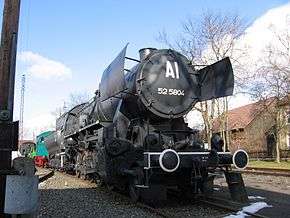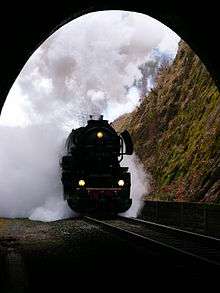Kriegslokomotive

Kriegslokomotiven (German: for "war locomotives", singular: Kriegslokomotive) were locomotives produced in large numbers during the Second World War under Nazi Germany. Their construction was tailored to the economic circumstances of wartime Germany along with conquered and occupied territories across Europe, taking account of the shortage of materials, the transportation of goods in support of military logistics, ease of maintenance under difficult conditions, resistance to extreme weather, limited life and the need for rapid, cheap, mass production. In order to meet these requirements, economic drawbacks such as relatively high fuel consumption had to be accepted.[1]
Construction
The war locomotives (or Kriegslokomotiven) were kept technically as simple as possible and the use of scarce materials (particularly copper) was dropped. Several German firms used prisoners from concentration camps as forced labour in the production of Kriegslokomotiven.[2] Borsig Lokomotiv Werke (AEG) used forced labour from KL Auschwitz,[3] Schichau-Werke used forced labor from KZ Stutthof,[4] and its subcamps.[5] DWM Posen (Deutsche Waffen- und Munitionsfabriken Posen) took over Polish manufacturer H. Cegielski – Poznań and turned its workforce into forced labour.[2] Oberschlesische Lokfabrik Krenau took over Polish manufacturer Fablok and used forced labour under threat of death.[2] Identical engines were produced in Vienna, Kassel, Berlin, Munich, Stuttgart, Kirchen, Plzeň (Pilsen), and Strasbourg.[3]
The manufacture of electric locomotives as Kriegslokomotiven was a special case, because they could only be used in the core network where there was the working infrastructure able to supply the current: power stations, overhead transmission lines, electricity substations and catenary. As a rule, locomotives were preferred that were dependent on additional infrastructure as little as possible. German electric locomotives were given aluminium windings in the traction motors and transformers, and the steam engines had steel fireboxes, hence the name Heimstofflok or 'home-grown loco'.
Classes
A Kriegslokomotive usually had two classifications: one based on the normal peacetime classification system and a separate wartime classification. For example, a wartime steam locomotive or Kriegsdampflokomotive (KDL) was given a KDL class as well as its DRG (Deutsche Reichsbahn) class. Likewise a wartime motorised locomotive or Kriegsmotorlokomotive had a KML class number and a wartime electric locomotive or Kriegselektrolokomotive would have a KEL class number. Besides the DRG, the German Armed Forces had their own locomotive classes: an Army locomotive was known as a Heeresfeldbahnlokomotive or HF and a Wehrmacht engine as a Wehrmachtslokomotive or WR.
The following classes of Kriegslokomotive were procured by the Deutsche Reichsbahn and other customers (industrial and military railways) during the Second World War:

- Steam locomotives (Kriegsdampflokomotive or "KDL")
- DRB Class 52 (KDL 1)
- BMB Class 534.0 (KDL 2)[6]
- DRG Class 42 (KDL 3)
- ELNA 6 0-8-0T industrial (KDL 4)
- 0-10-0T industrial (KDL 5)
- 0-8-0T industrial (KDL 6)
- 0-6-0T industrial (KDL 7)
- 0-4-0T industrial (KDL 8)
- 900 mm gauge 0-6-0T industrial (KDL 9)
- 900 mm gauge 0-4-0T industrial (KDL 10)
- HF 160 D (KDL 11)
- HF 70 C (KDL 12)
- Henschel "Riesa" type construction locomotive, austere version, (KDL 13)
- Internal combustion locomotives (Kriegsmotorlokomotive)
- WR 360 C 14 (KML 1)
- WR D 311 - 2 were used on the 80 cm railway guns. Also base of some post-war development.[7]
- DRG Köf II (KML 2)
- HF 130 C (KML 3)
- HF 50 B (KML 4)
- O&K MD 2 (KML 5)
- Twin-axled mining locomotives (KML 6, KML 7, KML 8)
- Electric locomotives (Kriegselektrolokomotive)
- DRG Class E 44 (KEL 1)
- DRG Class E 94 (KEL 2)
- Bo′Bo′Bo′ mining (KEL 3)
- 900 mm gauge Bo′Bo′ mining (KEL 4)
- 550–630 mm gauge Bo industrial (KEL 5)
- 550–630 mm gauge Bo′Bo′ mining (KEL 7)
- Bo Battery-electric mining (KEL 7, KEL 8, KEL 9)
- Fireless steam locomotives (Dampfspeicherlokomotive)
- 0-6-0 (KFL 1)
- 0-4-0 (KFL 2)
See also
- Einheitslokomotive
- Übergangskriegslokomotive - transitional war locomotives
References
- ↑ Jerzy Wasilewski (2014). "25 września. Wcielenie kolei polskich na Śląsku, w Wielkopolsce i na Pomorzu do niemieckich kolei państwowych Deutsche Reichsbahn (Takeover of Polish Railways in Silesia, Greater Poland and Pomerania)". Polskie Koleje Państwowe PKP. Retrieved 8 February 2014.
- 1 2 3 Michał Kubara; Beata Mamcarczyk; Marcin Paździora; Sandra Schab (2012). "Sosnowiec". Katalog Zabytków Techniki Przemysłowej Zagłębia Dąbrowskiego (PDF file, direct download 9.97 MB). Zagłębiowska Oficyna Wydawnicza Publishing. pp. 84–85. ISBN 978-83-928381-1-1. Retrieved 9 February 2014.
- 1 2 Eliah Meyer (July 1949). "List of german firms that used prisoners from concentration camps as slave labor". Catalogue of Camps and Prisons in Germany and the German-Occupied Territories. The International Tracing Service, ITS. Retrieved 11 August 2014.
- ↑ Geoffrey P. Megargee, USHMM (2009). The United States Holocaust Memorial Museum encyclopedia of camps and ghettos, 1933-1945. Indiana University Press. ISBN 0253354293. Retrieved 11 August 2014.
- ↑ J. Więsyk (2015). "Gdańsk-Kokoszki - KL Stutthof Sub Camp". Virtual Shtetl. POLIN Museum of the History of Polish Jews. Retrieved 10 March 2015.
- ↑ Overview at dampflokomotivarchiv.de
- ↑ "Wehrmachtslok" (link to file). Die Deutsche Reichsbahn 1933-1945 at FooBlog.
External links
- A compilation about the Class 53 project
- There is a relevant English-language forum at Railways of Germany